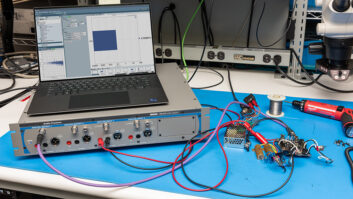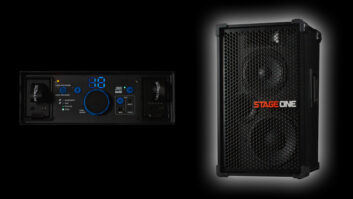HiQnet™-enabled Crown Audio CTs Series amplifiers with USP4AVB cards, dbx SC 32 Digital Matrix Processor, BSS Audio / NETGEAR® AVB bridges, and HiQnet System Architect™ were employed by On Stage Audio to create a topography for the future of A/V at the Compuware national sales meeting.
NORTHRIDGE, California — In a highly advanced, yet-remarkably simple audio system design that points to the future of professional-grade integration, On Stage Audio (OSA) this month deployed the world’s first real-world test of the IEEE 802.1 AVB Bridging protocol. OSA’s team, led by Jim Risgin, Vice President, configured and controlled a Crown Audio, dbx, and BSS Audio A/V system using Harman HiQnet for the Compuware national sales meeting in Detroit, Michigan and ran audio using Ethernet AVB standards.
The event, which took place at the Masonic Theater in downtown Detroit, allowed a crowd of 1,500 attendees to enjoy pristine digital audio and let
the audio systems crew experience the future of A/V systems configuration, one in which everything works, all the time, and in which simplicity, not complexity, is the norm.
This watershed event marked the first time that AVB — the only standard transport protocol that allows time-synchronized, super-low-latency streaming audio and video over IEEE 802 Ethernet networks – was used as the primary audio transport for a major professional system. Harman is a leader in the AVB initiative, chairing and editing the IEEE P1722 Committee and editing the IEEE P802.1Qat Committee and the company is also a pioneer in AVB switching and product development, via the groundbreaking efforts of the Harman Corporate Technology Group and System Development and Integration Group (SDIG). Their dedication to the development of AVB is signified by their membership in the AVnu Alliance; the industry forum dedicated to promoting the adoption of the IEEE 802.1 AVB and related IEEE 1722 and IEEE 1733 standards over various networking link-layers for the advancement of professional quality audio video.
At the core of Risgin’s design are 24 Crown CTs 3000 power amplifiers fitted with USP4/AVB cards, four 24-port BSS Audio / NETGEAR AVB bridges as well as four dbx SC 32 Digital Matrix Processors which were used as the AVB “on ramps� for the system processing. The entire system (DSP and AVB) was controlled using Harman’s HiQnet protocol and System Architect software.
Jim Risgin, himself an early and active contributor to the AVB movement, assembled the Compuware AVB system working closely with SDIG. Using the intuitive and customizable HiQnet System Architect drag-and-drop design interface to design his system, Risgin configured and programmed the dbx SC 32 Digital Matrix Processor for processing and using the AVB network as the matrix automatically instructed groups of Ethernet AVB amplifier channels associated with each physical zone to switch to that networked audio signal.
The dbx SC 32’s were deployed as the ‘on ramps’ were used to convert the incoming analog audio to digital AVB streams. Fourteen audio streams were then routed via HiQnet System Architect to the 24 Crown CTs amplifiers with Crown USP4 4th generation DSP-based PIP™ (Programmable Input Processor) input modules connecting the amplifiers to the Ethernet network. This enabled real-time transport of digital audio via Ethernet AVB and also allowed the CTs amplifiers to be remotely controlled and monitored via HiQnet System Architect.
“The systems performed flawlessly,� says Risgin, who notes that AVB-induced latency was less than 500 microseconds for all devices, and that delay from input to output maintained the <2ms specified by the AVB protocol. “Harman has done a wonderful job of making a complex process far more simple,� he states. “Everything on the network was completely transparent – troubleshooting was simple because we were able to verify that all the signal paths were correct, and there was instant metering available as soon as an AVB stream was connected to the network. The Crown amplifiers’ load-monitoring capability verified that each speaker was working and with the correct loading, and the drag-and-drop audio routing really streamlined our workflow process.�
Comparing his AVB experience with traditional system design and routing, Risgin identified what has made the establishment of the AVB protocol so critical. “We would have been working with either analog audio signals on twisted-pair copper cabling, with the potential for failure increasing as the number of signal paths increased or other IP based transport solutions that would increase the complexity immensely� he explains. “With analog we’d have had to deal with interference, hum, and noise rejection issues while other IP solutions would have required an IT technician— in short, we’d have been working in a different age. Even with the existing networked audio protocols, AVB improved the simplicity of coordinating the system and organization of the components. Ethernet AVB has changed everything – for the better.�
Echoing this sentiment, Adam Holladay, Market Manager for SDIG notes, “Where HiQnet simplifies and enables complex programming, monitoring and control, AVB simplifies and enables complex multichannel audio and video transport. The elegance and performance of the HiQnet and System Architect pairing is matched only by the comprehensive integration that is provided by AVB networking. The commitment of the AVnu Alliance to advance AVB as the universal standard for audio and video transport — indicated by the ever-increasing company membership — really shows that we truly can expect significant industry-wide benefits to many members of the professional A/V community in the not-too-distant future.�
Harman HiQnet is the world’s first connectivity and control protocol that integrates all product categories in the signal chain for professional audio systems of all types, size, and applications. Harman HiQnet no longer requires the user to manage multiple disparate operating systems or be responsible for programming individual signal processors, speaker controllers, wireless microphone systems, and mixing consoles. HiQnet was developed by engineers from across Harman’s Professional Division and is coordinated by the System Development and Integration Group (SDIG), a team of dedicated systems specialists based in Salt Lake City, Utah.
About On Stage Audio (OSA):
On Stage Audio (a division of OSA International, Inc.), one of North America’s leading audio production organizations, With operations in Chicago and Las Vegas, On Stage Audio can be reached by contacting Jim Risgin (630-227-1008, ext. 410, [email protected]) or Carmen Educate (702-458-0445, ext. 219, [email protected]).
For additional contact information see the OSA website at www.osacorp.com.
About Harman:
HARMAN (www.harman.com ) designs, manufactures and markets a wide range of audio and infotainment solutions for the automotive, consumer and professional markets – supported by 15 leading brands including AKG®, Harman Kardon®, Infinity®, JBL®, Lexicon® and Mark Levinson®. The Company is admired by audiophiles across multiple generations and supports leading professional entertainers and the venues where they perform. More than 20 million automobiles on the road today are equipped with HARMAN audio and infotainment systems. HARMAN has a workforce of about 11,000 people across the Americas, Europe and Asia, and reported sales of $3.2 billion for the last twelve months ended March 31, 2010. The Company’s shares are traded on the New York Stock Exchange under the symbol NYSE:HAR.
###







